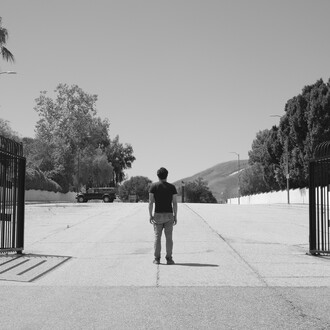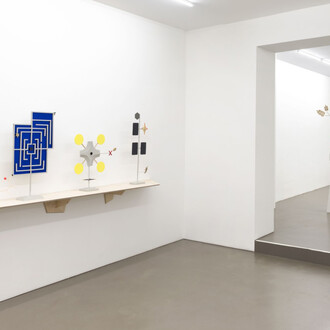This year, we are celebrating the artist and writer Jimmie Durham (1940–2021) with a solo exhibition on the theme of art and scientific thinking. Our collaboration with Durham began twenty-five years ago, in September 2000, with an exhibition of his videos and drawings. Since then, we have organised five solo exhibitions with and about Durham and published his poetry volumes Poems that do not go together (2012) and Particle/Word theory (2020), as well as the lecture The usual song and dance routine with a few minor interruptions (2013) which he gave in Glasgow in 2010.
Jimmie Durham and Barbara Wien discussed the idea for the current exhibition, “Art and science are the same thing.”,1 while working on Durham’s book Particle/Word theory. In the book, the world of science is ever-present; one poem is dedicated to the Austrian nuclear physicist Lise Meitner, another to the Brazilian mathematician Arturo Avila. Additionally, in the poem, Apocalypsis or The dragon in her cave, one finds sentences such as “Hypothalamic pro-opiomelanocortin (POMC) neurons promote satiety” – a direct quote from an article published in the scientific journal nature. The poem also mentions all eighteen authors of the article. What follows are passages about Durham’s personal experience of pain: “My feelings are indescribable. / Many of my feelings are indescribable. / The physiotherapist asked me to describe my pain on a scale of one to ten, / And if it was sharp, dull or pulsing. / It seems there may be no way / Of moaning eloquently / Yet many man-made musical instruments / Are capable / In the right hands.”2
What particularly occupied us during the publication of Particle/Word theory in 2020 was the question why the influence of science on art is not studied more thoroughly and why it often goes unrecognised. As a result, many artistic concepts that reflect the past century’s groundbreaking discoveries in the natural sciences remain overlooked – whether in biology, chemistry or theoretical physics. Back then, we spoke a lot about the work of Marcel Duchamp, as reinterpreted by Herbert Molderings,3 and had extensive discussions about Tomas Schmit’s work too. Schmit and Durham met in Berlin in 1999. Both drew and wrote literary and scientifically philosophical texts, and both had the remarkable ability to convey complex issues with ease and irony.
Now, five years after these conversations with Durham, who passed away in Berlin in 2021,4 we present works that revisit this discussion and exemplify Durham’s connection to science. For this, we have brought together works from 1989 to 2020, including the sculptures The Aharonov-Bohm effect (1989) and Heisenberg’s principle (1989); a table with objects, materials and text labels titled Various shapes and material (2009); the wall installation Electric (1995); eleven drawings from 2013; and seven drawings created in 2020 for a special edition of the book Particle/Word theory.
In Heisenberg’s principle (1989), the work broadly addresses Werner Heisenberg’s quantum theory, which followed Albert Einstein’s Special Theory of Relativity. Durham picks up on the discussion surrounding Heisenberg’s Uncertainty Principle and Schrödinger’s cat and labels a black box with the text: “Werner Heisenberg explained his ‘Uncertainty Principle’ by saying that if you have a kitten in a box it is neither alive nor dead. Until you open the box the kitten is only potentially alive or dead.”
In the wall sculpture, The Aharonov-Bohm effect (1989), Durham visualises a discovery described in the magazine New Scientist as one of the “Seven Wonders of the Quantum World.” The Aharonov-Bohm effect is a quantum-mechanical phenomenon in which charged particles are influenced by an electromagnetic field, even though they move exclusively through a region free of magnetic fields. On a text panel, Durham describes this inexplicable phenomenon and speculates: “As though the electrons ‘sense’ the hidden presence of the magnet, scientists assume that there is a more fundamental force of magnetism.”
In 1995, Durham created the installation Electric, which involves connecting cables, wooden and metal pieces, as well as a lobster claw, across an entire wall. The work relates to large-scale cable installations by Durham which are considered masterpieces in collections such as the M HKA in Antwerp, among others.
From the 1990s comes the assemblage These almost fit (1993), often described in Durham’s catalogues as a prime example of his combination of materials and words. In the same decade, Durham composed the sculpture Core sample from Stockholms Kulturhus, core sample from Stockholms Moderna Museet (1997), which consists of three core samples. In the first work, it is emphatically stated that parts of a shell ‘almost fit,’ leaving the meaning of the operation open. The rock samples from cultural institutions in Stockholm, reminiscent of geological research objects, also carry a sense of paradox. With this, Durham creates a certain degree of uncertainty, inviting inevitable questions: What is true? What is objective? What is a meaningful categorisation?
The table display case Various shapes and materials (2009) is one of Durham’s key works that attests to his passion for collecting and organising materials. The case contains mostly found objects from the street that caught Durham’s eye. These are, in themselves, worthless items which receive renewed attention; discarded things are presented as something valuable. A pocket alarm, a keyring and embossed leather pieces are classified as “Squarish things”; alongside them are two dried skin shreds labelled “Shark skin from Mexico”; and “Things of similar shape with holes” include thread spools and sieve-like metal pieces with punctures.
The eleven drawings from Untitled (2013) centre on statistical curves. Their titles are: On a scale of one through ten, Recalcitrant trends, III wind, Seven lines indicating various colours and trends, The turquoise line is probably indicative, Red and blue meeting, Water, Lighting and anger, Clearly, not everything functions, Indications of the frequent escape mechanisms of clarity, From normality… and More a process than a beginning and an end. The drawings parody statistical analyses. Durham’s scepticism towards the sense of scientific statistics is also reflected in his text Stone heart where he quotes the architect Yona Friedman: “The statistical method is the main tool of science today. But statistics only provide correct answers to irrelevant questions.”5
So, what is Durham’s particular stance towards science? What characterises it?
Durham does not see scientific methods as separate from his work as an artist. If you study his books and interviews, it becomes clear that he equates his work as an artist with that of a scientist. He sees himself as an analyst, observer and theorist, ready to question the concepts that explain the world – art and culture included. This ability to change one’s own conceptual foundations and redesign everything anew is what connects science and art.6 In Durham’s brilliant book, Between the furniture and the building (Between a rock and a hard place). Zwischen mobiliar und haus (Im gestein der zwickmühle) he explains: “I often describe myself as a theoretical biologist, which is not like a theoretical physicist, but almost the same. I like to think about biology and make up theories about biology. I do not have to know anything. I just have to think about things. I think there is not a division between art and science. Art and science are the same thing.”7
Analytical thinking, questioning and experimenting belong fundamentally to humanity. Time and again, Durham’s texts revolve around this conviction. This is particularly evident in the interview with Dirk Snauwaert, the director of Wiels in Brussels, who asks him why he reads so many difficult scientific books. Durham responds: “…science as an analytical concept of questioning and experimenting, and saying, let’s see, how does this work and what happens here, that’s genius, that’s what humans are about. If we don’t do that, we’re not doing a human project, I think. Our project is not to believe, not to find answers, it’s to be analytical, to do experiments that should lead us to the next experiment, it shouldn’t lead us to a cheap answer. And that’s why I love science; it’s so scientific. It’s not European, it doesn’t belong to white people, it’s a human thing. I don’t want art to be separated from other parts of life, and I also don’t want science to be separated from other parts of life.8
(Text by Barbara Wien)
Notes
1 Jimmie Durham, Between the furniture and the building
(Between a rock and a hard place). Zwischen mobiliar
und haus (Im gestein der zwickmühle), Verlag der Buchhandlung Walter König, Cologne 1988, published
in conjunction with the exhibitions at Kunstverein
München and daadgalerie, Berlin, p. 47.
2 Jimmie Durham, Particle word/Theory, Wiens Verlag and
Edition Hansjörg Mayer, Berlin and London 2020, unpag.
3 Herbert Molderings, Marcel Duchamp. Parawissenschaft,
das ephemere und der skeptizismus, Qumran, Frankfurt
am Main, Paris 1983; and Herbert Molderings,
Über Marcel Duchamp und die ästhetik des möglichen,
Verlag der Buchhandlung Walter König, Cologne 2019.
4 After Durham’s death in November 2021, Galerie
Barbara Wien held a tribute to the artist in January
2022, focusing on Durham’s literary texts and lectures.
For more information, see the exhibition review
“After Jimmie Durham” by Jess Chen in Texte zur
kunst, no. 126, June 2022, pp. 208–211.
5 Jimmie Durham, “Stone Heart,” 2000, cited in: Jimmie
Durham, Waiting to be interrupted. Selected writings
1993–2012, Mousse Publishing and M HKA, Milan
and Antwerp, 2014, p. 219.
6 Helpful thoughts on this topic can be found in the
book Helgoland. Wie die quantentheorie unsere welt
verändert by Carlo Rovelli, Rowohlt, Hamburg 2021,
e. g., p. 11. Published in English as Hegoland. Making
sense of the quantum revolution, Riverhead Books,
New York 2021.
7 Jimmie Durham, Between the furniture and the building
(Between a rock and a hard place). Zwischen mobiliar
und haus (Im gestein der zwickmühle), as above, p. 219.
8 “Dirk Snauwaert in conversation with Jimmie Durham,”
in: Jimmie Durham, Phaidon, London, New York 1995,
citations refer to the 2nd revised and expanded edition
2017, p. 25.
















